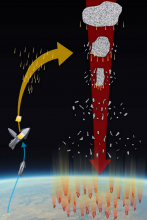Listen to today's episode of StarDate on the web the same day it airs in high-quality streaming audio without any extra ads or announcements. Choose a $8 one-month pass, or listen every day for a year for just $30.
You are here
Crater Hunting
An asteroid slammed into Earth almost 800,000 years ago. It left behind many souvenirs of the collision — black blobs of glass. But the spot where it hit has remained hidden — scientists haven’t found an impact crater. A recent study, though, says that could be because the crater is buried under volcanic rock.
The impact melted millions of tons of rock and dirt and blasted them high into the sky. As this debris fell back to Earth, some of it cooled to form blobs of glass known as tektites. And the glass from this collision has been found all over the place — across Southeast Asia and Australia, in southern Africa, and even in Antarctica. In fact, the glass may be scattered across a tenth of Earth’s surface or more — the largest tektite field on the planet.
A lot of research has zeroed in on Southeast Asia as the site of the impact — especially Laos and Cambodia. That includes the recent study. It places the impact in southern Laos.
Researchers say several bits of evidence support that idea. The chemistry of the tektites suggests the impact took place in a volcanic region, for example. Rocks near the site were smashed by a close impact. And the region’s gravitational field reveals a possible crater below the rocks. It measures about 10 miles across.
If that’s correct, then the asteroid slammed into a region that was already paved with volcanic rock. Fresh eruptions after the impact covered up the crater — hiding a cosmic scar.
Script by Damond Benningfield






